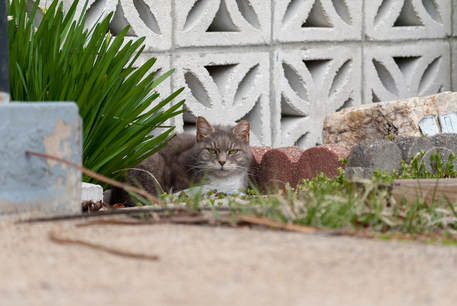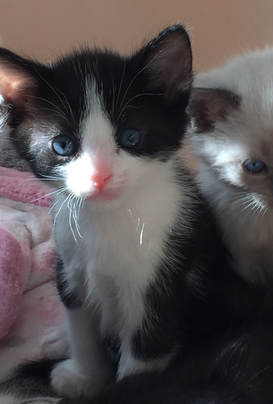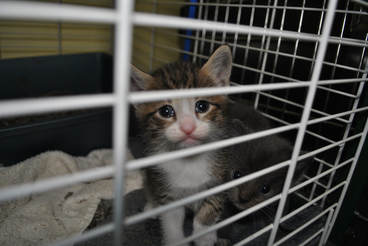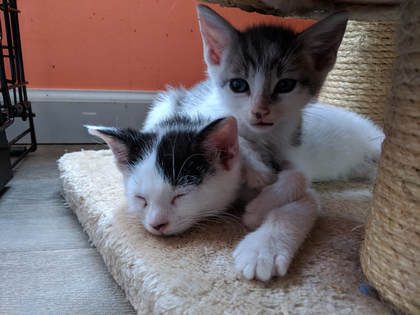 Often feral cats congregate near a food source, usually a nearby dumpster. Many of the colonies Alley Cat Rescue receives calls about are those living in apartment complexes. These cats usually live at apartment complexes for a variety of reasons: cats may be abandoned by renters, there is a steady supply of garbage to scavenger through (including rats and mice), and there is more likely to be multiple feeders, among other reasons. Colony caregivers should be careful when helping cats at an apartment complex. Management may be resistant or hostile towards the cats and may try to reprimand caretakers through fines or eviction. A common concern heard by housing managers is that feeding the feral cats will attract other wildlife species to the complex. It is important that colony caretakers make sure the cats are safe at the complex and try and alleviate some potential concerns. Angry housing managers may call animal control, prompting an eradication plan where the cats are trapped and killed. Here are some tips to create a positive environment for cats and people:
59 Comments
5/14/2018 Action Alert: Help Pass the KITTEN Act to Prevent Harmful and Unnecessary Kitten Experiments Funded by TaxpayersRead Now Last week, we let you know about the cruel kitten experiments being conducted by the United States Department of Agriculture (USDA). Researchers purposefully infect kittens with toxoplasma gondii by feeding them tainted meat and then kill the kittens after they shed the virus in their stool. These experiments have been occurring for years and have resulted in the death of many innocent lives. The exact number of kittens used in the experiment is unknown; White Coast Waste Project, who broke the story, estimates 100 kittens a year, although the USDA refutes this number. Not only is the use of kittens as test tubes harmful and unnecessary, but the kittens are simply killed and incinerated at the end of experiments. As Representative Michael Bishop puts it in a stern letter to Secretary Sonny Perdue, “[the USDA] was treating the life of animals with such contempt.” Toxoplasma gondii is not a death sentence for cats and there is no reason the kittens cannot be treated and adopted into loving homes. Representative Mike Bishop followed up his letter to the USDA by introducing H.R. 5780 - Kittens in Traumatic Testing Ends Now Act of 2018 (KITTEN Act). The bill will direct the Secretary of Agriculture to end the use of cats in experiments that cause pain or stress, effectively ending not only the toxoplasma gondii tests but many other invasive experiments as well. Reach out to your legislators and let them know you support H.R. 5780. A companion bill has not been introduced in the Senate yet, so ask your Senators to introduce a Senate bill on ending cat experiments today! H.R. 5780 is headed to the House Committee on Agriculture for a vote. If your representative is on this committee it is especially important that you contact them and ask them to vote for H.R. 5780. Check and see if your representative is on the committee here. You can also help end the toxoplasma gondii kitten experiments by signing Alley Cat Rescue’s petition.  News is breaking that the United States Department of Agriculture is using hundreds of healthy kittens for scientific research and then simply killing the kittens once the experiment is done. According to White Coat Waste Project, a non-partisan watchdog group, the USDA facility in Beltsville, Maryland uses up to 100 kittens a year to study toxoplasma gondii by intentionally feeding the cats meat infected with the parasite. The researchers then collect the parasite from the cats’ feces and after 2-3 weeks of collection, kill and incinerate the kittens. These experiments have been occurring for decades, undoubtedly resulting in the death of many helpless kittens. Science has evolved beyond these outdated research models and many researchers are now calling for an end to animal testing altogether. The European Union has made strides to end animal testing and has banned all cosmetic testing on animals. The European Commission, an institution that proposes and implements legislation in the EU, supports the ultimate goal of phasing out all animal testing and replacing it with scientifically valid alternatives[i]. Support for non-animal models seems to be on the rise, likely because non-animal models are more accurate, less time-consuming and more humane. Alternatives to animal testing include computer models, cell and tissue cultures and humans who already have the disease or ailment. Pharmaceutical drugs tested on animals have over a 90% failure rate on humans. This has lead the Food and Drug Administration, the National Institutes of Health and the Defense Advanced Research Projects Agency to spend millions on developing a non-animal alternative to drug testing[ii]. This model, “human-on-a-chip”, is a miniaturized version of human organs such as livers, lungs and intestines. Many have hailed scientific advancements such as this because these studies will better translate to humans, rather than animals who have many biological differences to people[iii][iv]. Regarding the kitten study on toxoplasma gondii, non-animal models already exist. According to a review in Trends in Parasitology entitled “Toxoplasma gondii: One Organism, Multiple Models”, using test tube samples of toxoplasma gondii is an effective method of studying and experimenting on the parasite[v]. There is no need to force kittens to suffer, especially when humane alternatives exist. Michigan representative Michael D. Bishop has also shown concerns over these harmful and archaic experiments in a stern letter to Secretary Perdue, stating, “As you can imagine, I was shocked to hear that the USDA, the very organization set out to enforce animal welfare laws and regulations, was treating the life of animals with such contempt (…) it appears that this project uses kittens as test tubes. Put simply, it creates life to destroy life.” Alley Cat Rescue is committed to helping all cats. This is why we started a petition to demand that the USDA end these kitten experiments. You can sign our petition here. [i] Cronin, M. European Commission. (2017). Non-Animal Approaches: The Way Forward. [ii] Frequently Asked Questions About Animal Testing (n.d.). Retrieved from http://www.pcrm.org/research/animaltestalt/tailtox/frequently-asked-questions-about-animal-testing [iii] Woods, B. (August 15, 2017). It sounds futuristic, but it’s not sci-fi: Human organs-on-a-chip. Retrieved from https://www.cnbc.com/2017/08/14/fda-tests-groundbreaking-human-organs-on-a-chip.html [iv] Knight, A. (2008). Non-Animal Methodologies within Biomedical Research and Toxicity Testing. Alternatives to Animal Experimentation, 25, 213-231. [v] Szabo, E.K. & Finney, C.A.M. (2017). Toxoplasma gondii: One Organism, Multiple Models. Trends in Parasitology, 33(2), 113-127.  This month is all about kittens at Alley Cat Rescue! Kitten season has arrived and Alley Cat Rescue is hearing from many passionate supporters asking how they can help. There are many ways you can get involved to help kittens, whether it is hands-on or through the comfort of your home. Alley Cat Rescue has been hard at work for kitten season and has launched a campaign as part of the Saving Pets Challenge to raise funds to help cats in Los Angeles. We are beginning week 2 of our challenge and are already almost 30% to our $5,000 goal. We would love to win this week’s challenge where $5,000 goes to the group that raised the most donations from 5/8-5/15. You can get involved helping cats by joining our team as a fundraiser or by donating directly to the campaign. Check it all out here! You can also get involved by signing our petition to end the harmful and unnecessary experiments the USDA is conducting on kittens. The USDA is killing up to 100 kittens a year during research on Toxoplasma gondii. The kittens are purposefully exposed to the parasite and killed at the end of the experiment. These tests are simply barbaric and cruel. Further, more humane, non-animal models exist for studying toxoplasma gondii. Sign our petition here and share with friends and family to spread the word. If you are more of a hands-on person, now is a great time to get out in the field and trap-neuter-return cats. During kitten season, local shelters see an influx of kittens brought to them. Unfortunately, these shelters do not always have the resources to care for kittens and may euthanize many healthy kittens. TNR stops the breeding cycle and prevents kittens from being born to an unknown fate on the street. Watch our how-to video to begin TNRing cats yourself: Thank you for all you do for kittens! Together we can make a huge difference in the lives of many animals.
 In 2015, Kristen Lindsey made national headlines after she killed a cat who had wandered onto her property with a bow and arrow and then posted on social media bragging about it. Lindsey posted a photo on Facebook of her smiling and holding the cat on the end of her bow and said, “My first bow kill lol. The only good feral tomcat is one with an arrow through its [sic] head! Vet of the year award…gladly accepted.” Lindsey tried to excuse her cruel behavior by claiming she thought the cat she killed was a feral cat. The cat is actually believed to be her neighbor’s companion animal named Tiger. Regardless of whether the cat was owned or feral, Lindsey’s actions are inexcusable- especially as a veterinarian who is supposed to save animals. Feline expert and Texas veterinarian Dr. William Folger even testified that Tiger appeared to still be alive after he was shot in the head and was used for the photo . Thankfully the Texas Board of Veterinary Medical Examiners’ also became concerned with her actions and revoked her veterinary license. The Board revoked her license for five years, disallowing her from practicing for the first year. After that, she could practice under supervision and would need to complete continuing education in animal welfare classes. This punishment was a good start but not enough for a person who has proven that they do not have the compassion or judgement needed to properly care for animals. After a long legal battle and multiple appeals from Lindsey, the Texas Third Court of Appeals ruled against her in two separate appeal cases last week stating that they disagree with Lindsey’s challenges to the Board’s authority to seek disciplinary action and her challenges to findings in the case. Lindsey’s veterinary license will stay revoked. Alley Cat Rescue is happy that Tiger is receiving the justice he deserves. This poor cat had to die in a barbaric and painful manner just for a few social media likes. We hope this case illustrates just how cruel eradication methods against feral cats can be, especially when people decide to take actions into their own hands. We at Alley Cat Rescue have been ramping up our trap-neuter-return (TNR) work in Los Angeles. Currently, TNR groups are overwhelmed with the large number of cats in need of help and the lack of support from city government. We have been in the field TNRing and seen the shortage of resources first hand. This fieldwork brought us to the Baby Panther kittens.
These tiny black kittens were found while an ACR volunteer was TNRing a local colony. The kittens were malnourished and had severe URI infections. One of the kittens had such a severe infection that he couldn’t even open his eyes. Our experienced volunteer searched the area but could not find their mother. She knew she had to act fast to save the kittens and decided to take them into her care. The Baby Panthers proved to be a full-time job! They required warm compresses, antibiotic treatments and daily eye ointment and eye drops, on top of the normal around-the-clock supplemental feedings kittens receive. Our volunteer got some unexpected help when another feral mama cat she was fostering began to show interest in the kittens. The mama cat was introduced to the kittens and immediately accepted them as her own. The mama cat even let them nurse while she cared for her own litter of kittens as well. Although the mama cat is not socialized to people, she is very gentle and maternal towards the kittens and diligently watches over them. After three weeks of diligent treatment, the kittens’ eyes are healed. Unfortunately, many kittens born on the streets suffer with similar conditions as the Baby Panthers, but never receive the care they need. This is why TNR is so important. Trappers are able to reduce cat overpopulation through sterilization and identify at-risk kittens in need of help. Now the Baby Panther kittens are almost ready for adoption and a lifetime of love. We want to increase our impact on the cats in Los Angeles this year, and we need your help to do it. This week we launched our campaign to raise funds to sterilize feral cats in LA as part of the Saving Pets Challenge. At the end of the month-long challenge, the non-profit with the most dollars raised wins a bonus prize of $50,000! You can support our work to help the estimated 1-3 million feral cats in LA by joining our campaign as a fundraiser or by making a donation to the campaign here: https://www.crowdrise.com/o/en/campaign/alley-cat-rescue1 Thank you for your generous support, and together we will continue to make a life-saving difference for the free-roaming cats of LA. |
Details
AuthorAlley Cat Rescue is leading in the way in promoting humane and compassionate care for ALL cats. Archives
January 2024
Categories
All
|
 RSS Feed
RSS Feed